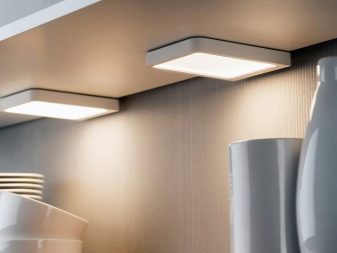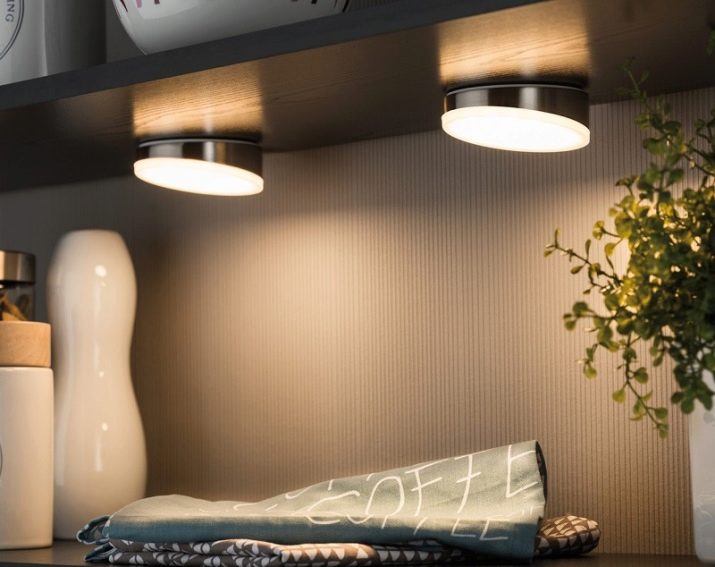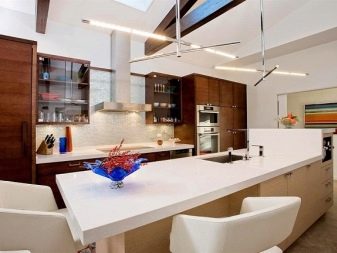Currently, the owners of residential premises are planning to repair not only to decorate the rooms, but also, possibly, to derive any benefit. Including a popular trend is energy saving. For this, LED lamps are installed in the apartment. What is it, what are the pros and cons, and how to properly place these lighting fixtures in the kitchen, we will talk in our article.

Advantages and disadvantages
Like every device, LED lamps have their own advantages and disadvantages. For starters, it makes sense to dwell on the pros.
As already noted such lighting devices have an energy-saving function. They are based on LEDs. When compared with conventional incandescent bulbs, the savings can be substantial, since electricity in this case is spent much more economically. Consumers believe that if you place LED lights throughout the apartment, you can save on electricity by 30-45 percent. Despite the higher cost, such lamps pay off quite quickly. In addition, they are much less likely to fail.
Next, it is necessary to note the compact dimensions of such devices. And although the LEDs are very small, but they are able to perfectly illuminate the room. This allows you to not install volumetric fixtures, which successfully saves space, and this point is especially important for small kitchens.


The service life of LEDs is many times higher than that of the same conventional incandescent bulbs. The main thing is to purchase quality goods from a trusted manufacturer, then the payback will not take long.
Besides, the owners of the room always have the opportunity to turn on the imagination and create a unique design of the room. LEDs can have a different spectrum of light emission. In addition to the usual yellow, it can be white. And there is also the possibility of dimming the LED lamp with the choice of the required degree of brightness, which can be adjusted both automatically and manually. This will help to make the stay in the kitchen even more comfortable and cozy.
However, for all the positive aspects, it is impossible not to say about the minuses. Individual LEDs may not last long. This with other schemes of operation of the lighting network leads to sad consequences - the operation of the entire circuit will be disrupted until a faulty lamp is replaced.


Kinds
LED luminaires are becoming more common in the modern market. Let's talk about their main types.
The first group is furniture. Most often they are round and have a separate ceiling. The purpose of such lamps is to divide the kitchen areas. They can be made in the form of tapes located in a plastic shell. They are fixed on the facades of the kitchen to illuminate for the most part the countertop, which is especially important during the cooking process. Such lamps are inexpensive, as they consist of the simplest LEDs. And at the same time they are very reliable and do not require special care.

The second group - lamps for cabinets. They are characterized in that they have a separate shade with light diodes. Such lamps can illuminate both the internal and external space of cabinets. They can be built-in or independent elements.
Such plafonds have a lifespan of at least 5 years.

Battery-powered products, by contrast, are the most affordable. They do not need to be included in the general power supply network. Plafonds are installed in the kitchen so that if necessary, you can quickly and seamlessly replace the batteries. On sale are quite common and enjoy well-deserved popularity. Very useful when the central lighting is suddenly turned off.

And finally overhead lights. They are no less popular than the previous view, they are easy to install and operate. Outwardly, they consist of a plastic case in which the LED lamp is located. The body is fixed to the surface with an adhesive layer. This is also a minus, since the adhesive layer tends to dry over time, so the structure may one day simply fall off the surface.

Recommendations
Those who decided to install LED lights in the kitchen, experts give several recommendations. To follow it or not is the business of every consumer, but familiarization will still not be unnecessary.
To be able to change the angle of incidence of light, you should use linear models with a rotary base. They are most often used for location in the working area.
Modular options are an indispensable thing for creating general lighting. In this case, they are located on the ceiling.
Touch models are perfect for the work area. They can be placed directly above the countertop.


Overheads are suitable for placement anywhere. They can be used for zoning the room. They are especially relevant among owners of small kitchens. Wireless models often have a built-in motion sensor.
As for recessed fixtures, they are universal. They can be cut into any surface. For small rooms, this option is also relevant, as it helps to significantly save space. With the help of several such devices, you can create a complete lighting of the kitchen or focus on a specific area.
LED downlight can be anything. Someone is attracted to angular options, while someone likes flat models or seeks to find trendy volumetric options.
The most important thing is to withstand the style of the room and calculate the layout of lighting fixtures in advance.


How to choose
If the choice in favor of LEDs is made, it will be useful to find out how to purchase a lamp, necessary in each specific case, without making mistakes. First you need to calculate the power. In this case, to simplify the task, it should be taken into account that a conventional 60 W light bulb is replaced by a 6 W LED.
As for the kitchen, the optimal use is a 12 W lamp.
We must not forget that in such rooms the humidity is often increased, and the use of these models is absolutely safe.


It is worth contacting only trusted stores and using products exclusively from reliable manufacturers.
Designers recommend paying attention to the color scheme. If we are talking about ceiling lights, you can use warmer lighting, when illuminating functional areas, it is permissible to use cold light.
Another challenge is choosing the right lamp design with a switch.
There can only be one recommendation. The main thing is to maintain the overall style.


Where to place
The main advantage for which LED lighting products are so appreciated by consumers is that they can be placed literally everywhere. This is what the owners of residential premises use, including their imagination and developing the most unexpected options.
If you plan to hang a chandelier, it is recommended to focus on a model that has not too many decorative elements. Wipe and wash such a device will be much easier. If you wish, you can replace it with a certain number of spotlights installed on the ceiling. And it will be most convenient to place rotary lamps on the ceiling pole.


As for the working area, backlighting in this area is never superfluous. Furniture fixtures are best suited. They are located directly above the table. You can pay attention to models with touch controls. And also LED strips are installed, which are stretched to various distances.
Lighting and cabinets with cabinets will not interfere. Lighting devices are placed in the upper part in the center. If there are glass elements in the headset, this effect will look especially original.


You can learn about how to organize LED lighting in the kitchen in 5 minutes from the video below.










